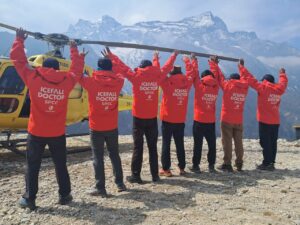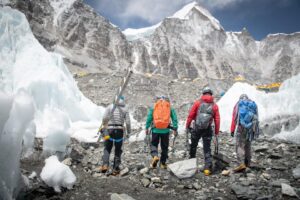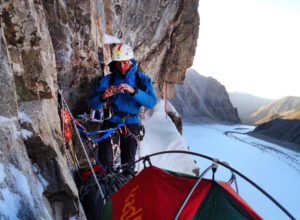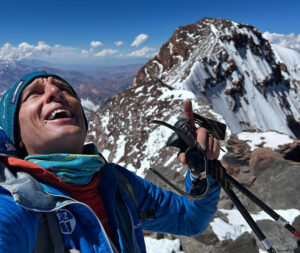Fixed ropes can make the difference between success and failure, or even life and death.
Are ropes a new trend?
Fixed ropes in the Himalaya have always been part of expedition-style mountaineering. The first high-altitude climbs, with only one team on the mountain, followed this approach, which even predated the use of oxygen. In expedition-style mountaineering, teams make progressive rotations up and down a route, acclimatizing while adding ropes to make the next round quicker and safer.

The rope-fixing team for Everest and Lhotse poses with the ropes. Photo: Seven Summit Treks
The commercialization of the normal routes on popular peaks, from Ama Dablam to the 8,000’ers, has led to more fixed ropes in more places. An organized system decides who fixes the ropes and where. It also decides how costs are shared among those who use them.
What is exactly a fixed rope?
A fixed rope is a semi-static or static nylon rope, secured at one or both ends to rock or ice on the mountain. Climbers use it as both a lifeline and a ladder when they go up and down a particular section.
A lead group, usually of Sherpa guides, fixes the ropes for everyone. Fixed ropes make a climb significantly safer on peaks where altitude increases the possibility of mistakes. Small alpine-style teams can proceed quickly and lightly without fixed ropes, but they need better technical skills and take higher risks.

Jumaring up fixed ropes on Annapurna: Photo: Wikipedia
Traditionally, ropes were fixed only in the hardest sections or in those places exposed to falling rocks or ice. Nowadays, guided expeditions fix virtually the entire route to keep clients from falling or losing their way.
On Everest, for instance, the route is fixed all the way to the summit except for a flat area in the Valley of Silence, before Camp 2. On K2, guides set ropes on the huge slope between Camp 3 and Camp 4. This keeps clients from falling into a crevasse or getting lost in the dark or in poor visibility, especially on the descent.
How do they work?
To ascend and descend fixed ropes, climbers use handheld jumar devices to go up. Jumars attach to both the rope and to a climber’s harness. The jumar slides up a rope easily, but teeth stop it from sliding back down, preventing any potential fall.
While descending, climbers secure their way with a lifeline and carabiners from section to section. Depending on the steepness, they may just roll the rope around their arm or use a figure-8 descender to rappel down. The gear used and the different techniques must be learned in advance, although it is not uncommon for some clients to be taught when they arrive in Base Camp or during preparatory climbs.

Cowstail with carabiner and a jumar to secure oneself onto fixed ropes. Photo: Tim Mosedale
British guide Tim Mosedale, who has over 20 years of experience guiding on Everest and other Himalayan giants, has put together an excellent tutorial for those who want to know more about how to ascend ropes.
Getting used to the jumars, slings, and carabiners, and practicing their use with mittens and an oxygen mask on is vital. A climber’s life may depend on it. Mistakes when clipping and unclipping between sections of rope have led to many fatal accidents.
Who fixes the ropes and who foots the bill?
The answer to that question gets more complex as the number of teams in Base Camp increases, and as they become mostly guide-client groups. Not long ago, two or three small teams gathered at the base of the highest mountains. Everyone just climbed and fixed at their convenience, collaborating on an ad hoc basis.
By the turn of the millennium (and a decade earlier on Everest), the big mountains became more popular, and ad hoc wasn’t good enough. Some teams were better equipped, stronger, and more skilled than others.
This caused unfair situations where some did all the work of breaking trail and fixing ropes, while others just jumared up the well-packed path. It was doubly irritating for commercial leaders when some “independent” climbers criticized their methods but were happy to use the same ropes and the trail as everyone else.

Fixed ropes on Everest’s Khumbu Icefall. Photo: Madison Mountaineering
Base Camp negotiations
To avoid such dynamics, all teams started meeting in the mess tent to decide how best to share the work. Each team offers its services, ropes, and other fixing gear. Alternatively, it pays others for their effort. This is still the norm on Pakistan’s 8,000’ers.
Nowadays, on the big peaks, even independent climbers rely on commercial outfitters to arrange their logistics at least until Base Camp. Thus, the companies themselves generally come to financial arrangements even before the expeditions begin.
Nepal, in particular, has become quite sophisticated. In some cases, official organizations take responsibility. For Everest’s Khumbu Icefall, the Sagarmatha Pollution Control Committee assigns a special team of Icefall Doctors to fix the ropes in that dangerous area.
Elsewhere, the Expedition Operators Association assigns the rope fixing by contract: One company (often the biggest, Seven Summit Treks) will fix Everest and Lhotse from Camp 2 onward. Other companies may get the contract for Manaslu and Ama Dablam. The rope-fixing companies are paid from the climbing permit fees from all companies on the mountain.
In China, rope fixing is the responsibility of a state-run mountaineering association. However, China has not opened its mountains to foreign climbers since the beginning of the pandemic and does not seem in a hurry to reopen them.

A climber practices using fixed ropes. Photo: Sandt Hazledine/Adventure Consultants
Why should anyone want to fix ropes anyway?
The good thing about fixed ropes is that once the slow, laborious work of putting them in place is done, clients (or climbing partners) can follow relatively quickly to the summit. On crowded mountains such as Everest, where good weather can be scarce, this is a major advantage.

The first to the top avoid the queues. On the way up Everest to Camp 3. Photo: Pioneer Adventure
For outfitters, leading the way also bestows prestige and increases visibility among potential clients. Also, local guides increase their reputations and cachet (and earn a juicy bonus) with every summit they reach. Being part of the rope-fixing team is the best guarantee of a quick and certain summit.
What if I don’t want to use the ropes?
Using fixed ropes is not mandatory. But realistically, climbers on normal routes all tread the same well-packed trail, with the ropes right there. Mountains are full of unseen hazards. Not clipping to the ropes greatly increases the danger. A climber doesn’t get bonus marks for using a packed trail but eschewing the rope at his or her feet. So why not clip in?
The question of payment can become testy. On some peaks, climbers on a budget may refuse to use the ropes and so consider that they don’t have to pay. International guides have told ExplorersWeb that in this situation, they try to encourage everyone, nicely, to contribute.
What about climbing ahead of the rope-fixing team or a couple of metres to either side? Not a good idea. The rope fixers do not like to have climbers right above them, where they might dislodge chunks of ice or rocks or trigger avalanches.
These days, commercial rope fixers are usually Nepali mountaineers (including in Pakistan). They are usually nice guys, but if crossed, some may get not so nice. Simone Moro, Ueli Steck, and Jon Griffith endured a very unpleasant episode on Everest in 2013 when they climbed near the rope fixers.
Practically speaking, if a team really wants to climb an 8,000m peak self-sufficiently, it needs to do it in the off-season, or pick a route that is not the normal highway.
What happens with the ropes at the end of the climb?
Well… Climbing teams are supposed to leave no trace, but the reality is usually not so simple. Expeditions try to retrieve their higher camps when they descend, but the ropes are different. Tired, heavily loaded climbers need those ropes to make it down safely. Even if the last person down could theoretically cut the ropes after descending, there are usually other priorities.

Old ropes on K2. Photo: Elia Saikaly
Some teams do retrieve at least some old ropes the following season, especially if they are in bad shape or if they are the same color as the new ropes that they are about to fix.
From time to time, special route-cleaning initiatives take place. More often, avalanches or ice movement sweep the ropes down to the glaciers. Striking a balance between local economies and a fragile ecosystem is always difficult in the Himalaya.






